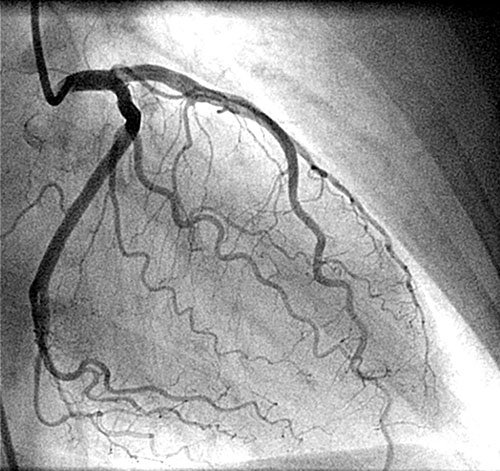Coronary angiography is a procedure that uses a special dye (contrast material) and x-rays to see how blood flows through the arteries in your heart.
Why the Test is Performed
Coronary angiography may be done if:
- You have angina for the first time.
- Your angina that is becoming worse, not going away, occurring more often, or happening at rest (called unstable angina)
- You have aortic stenosis.
- You have atypical chest pain, when other tests are normal.
- You had an abnormal heart stress test.
- You are going to have surgery on your heart and you are at high risk for coronary artery disease.
- You have heart failure.
- You have been diagnosed as having a heart attack.
How the Test is Performed
Coronary angiography is often done along with balloon and stent. This is a procedure which measures pressures in the heart chambers.
Before the test starts, you will be given a mild sedative to help you relax.
An area of your body (the arm or groin) is cleaned and numbed with a local numbing medicine (anesthetic). The cardiologist passes a thin hollow tube, called a catheter, through an artery and carefully moves it up into the heart. X-ray images help the doctor position the catheter.
Once the catheter is in place, dye (contrast material) is injected into the catheter. X-ray images are taken to see how the dye moves through the artery. The dye helps highlight any blockages in blood flow.
The procedure most often lasts 30 to 60 minutes.
If a blockage is found, your provider may perform a percutaneous coronary intervention (PCI) to open the blockage. This can be done during the same procedure, but may be delayed for various reasons.
How to Prepare for the Test
You should not eat or drink anything for 8 hours before the test starts. You may need to stay in the hospital the night before the test. Otherwise, you will check in to the hospital the morning of the test.
You will wear a hospital gown. You must sign a consent form before the test. Your health care provider will explain the procedure and its risks.
Tell your provider if you:
- Are allergic to any medicines or if you have had a bad reaction to contrast material in the past
- Are taking Viagra
- Might be pregnant
How the Test will Feel
In most cases, you will be awake during the test. You may feel some pressure at the site where the catheter is placed.
You may feel a flushing or warm sensation after the dye is injected.
After the test, the catheter is removed. You might feel a firm pressure being applied at the insertion site to prevent bleeding. If the catheter is placed in your groin, you will be asked to lie flat on your back for a few hours to several hours after the test to avoid bleeding. This may cause some mild back discomfort.
Phyathai Sriracha Hospital have Coronary Angiogram on promotion at 36,000 Baht and if you would like any information on this or would like to make an appointment to see a Cardiologist then please contact on telephone no 087-100-0990 email [email protected] www.phyathai-sriracha.com











